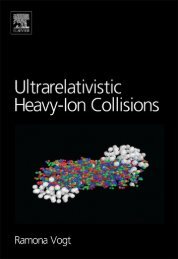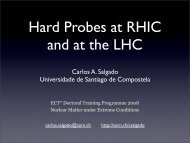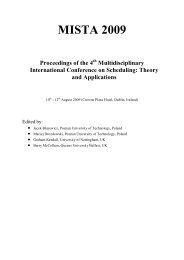Advances in perturbative thermal field theory - Ultra-relativistic ...
Advances in perturbative thermal field theory - Ultra-relativistic ...
Advances in perturbative thermal field theory - Ultra-relativistic ...
You also want an ePaper? Increase the reach of your titles
YUMPU automatically turns print PDFs into web optimized ePapers that Google loves.
Thermal <strong>field</strong> <strong>theory</strong> 393<br />
Figure 12. One-loop diagrams <strong>in</strong> HTL-resummed perturbation <strong>theory</strong> contribut<strong>in</strong>g to the gaugeboson<br />
self-energy <strong>in</strong> pure-glue QCD. HTL-resummed quantities are marked with a blob.<br />
dist<strong>in</strong>guish between spatially transverse and longitud<strong>in</strong>al polarizations. However, as will be<br />
discussed further later, the limit k → 0 <strong>in</strong>volves IR problems, and there are even explicit<br />
calculations [337, 338] that claim to f<strong>in</strong>d obstructions to this equality, which are however<br />
contradicted by the recent work of [339].<br />
In the simpler φ 4 -<strong>theory</strong>, the long-wavelength plasmon damp<strong>in</strong>g constant has been<br />
calculated <strong>in</strong> [64,65] and it has been shown <strong>in</strong> [340–343] that this quantity can also be extracted<br />
from classical <strong>field</strong> <strong>theory</strong> after <strong>perturbative</strong>ly match<strong>in</strong>g to the HTL mass.<br />
7.2. NLO correction to the plasma frequency<br />
In [344], Schulz has calculated also the real part of the NLO contribution to the gluon<br />
polarization tensor <strong>in</strong> the limit of k → 0, which determ<strong>in</strong>es the NLO correction to the gluonic<br />
plasma frequency.<br />
The orig<strong>in</strong>al power-count<strong>in</strong>g arguments of [213] suggested that besides one-loop diagrams<br />
with HTL-resummed propagators and vertices given <strong>in</strong> figure 12 there could be also<br />
contributions from two-loop diagrams to relative order g. The explicit (and lengthy) calculation<br />
of [344] showed that those contribute only at order g 2 ln(1/g) rather than g, and the NLO plasma<br />
frequency <strong>in</strong> a pure-glue plasma was obta<strong>in</strong>ed as<br />
ω pl =ˆω pl [1 − 0.09 √ Ng]. (7.2)<br />
In this particular result, HTL-resummed perturbation <strong>theory</strong> turns out to give a moderate<br />
correction to the lead<strong>in</strong>g-order HTL value even for g ∼ 1.<br />
7.3. NLO correction to the Debye mass<br />
Poles of the gauge-boson propagator at ω0, the A-branch<br />
of the HTL propagator becomes unscreened <strong>in</strong> the static limit. In QED, a ‘magnetic mass’ is<br />
forbidden by gauge <strong>in</strong>variance [215,222], but some sort of entirely non-<strong>perturbative</strong> magnetic<br />
mass is expected <strong>in</strong> non-Abelian gauge theories <strong>in</strong> view of the severe IR problems caused by<br />
the self-<strong>in</strong>teractions of massless magnetostatic gluons [149–151].<br />
Branch B, on the other hand, conta<strong>in</strong>s the <strong>in</strong>formation about screen<strong>in</strong>g of (chromo-)electric<br />
<strong>field</strong>s as generated by static charges (Debye screen<strong>in</strong>g). The Debye mass given by the lead<strong>in</strong>gorder<br />
HTL propagator is ˆm D = √ 3ω pl .<br />
The evaluation of corrections <strong>in</strong> <strong>thermal</strong> perturbation <strong>theory</strong> aga<strong>in</strong> requires resummation.<br />
Even though the non-localities of the HTL effective action do not play a role <strong>in</strong> the static limit,<br />
historically these corrections have been determ<strong>in</strong>ed for QCD, as well as for (ultra<strong>relativistic</strong>)<br />
QED, only after the more complicated cases of gluonic plasmon damp<strong>in</strong>g and the NLO plasma<br />
frequency discussed above had been mastered.







